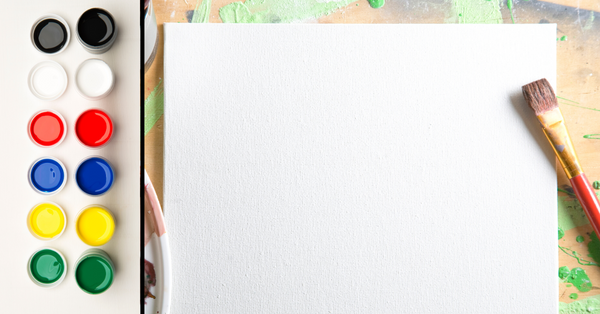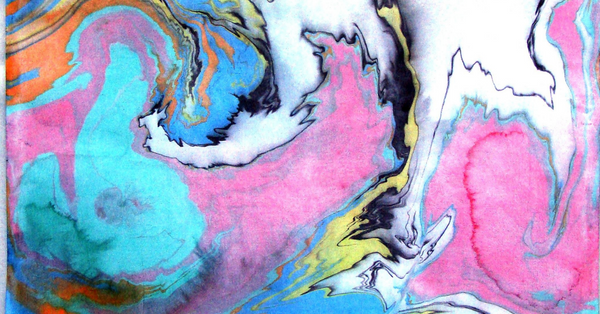
Most of us remember using tempera paint in elementary school. Often known as “poster paint,” this popular paint medium is easy to apply and wash off, making it great for kids.
But believe it or not, this “paint for kids” is also used by professionals from time to time. And yes, you can use tempera paint on canvas. Keep reading to learn more about the medium, along with a step-by-step guide for how to use tempera paint on canvas.
TABLE OF CONTENTS
What is Tempera Paint?
Tempera paint is a water-based paint made with a binder and a pigment. It is completely safe as it is toxic- and allergen-free.
Tempera is simple to use, available in a variety of vibrant hues, incredibly flexible, and simple to clean up with just soap and water. Kids’ tempera paint is frequently mistaken for “egg tempera,” although this is an entirely different substance.
Challenges of Using Tempera Paint on Canvas
Tempera can definitely be used on canvas. But, like with anything, it has its own set of challenges.
Viscosity
Viscosity is notably the biggest challenge. Tempera paint is a thicker, more viscous type of paint compared to other mediums like oil and acrylic. This means it can be more difficult to move and manipulate on the canvas, as it doesn’t spread as easily as thinner paints.

To help thin the paint and make it easier to manipulate, some artists add a medium like water, glycerin, or egg yolk to the paint. This helps to reduce the thickness and makes the paint easier to move around the canvas. However, adding a medium can also change the overall look and feel of the painting, so it’s important to experiment with different mediums to find the right balance of thinness and texture.
Durability
Additionally, unlike oil, tempera paint does not age well. Its impermanence causes it to become less clear with time and has a lifespan of only two to five years, whereas acrylic can last for up to 15 years. Also, the paint must be sealed and varnished to ensure that it does not fade or crack over time.
Blending & Layering
Tempera paint can also be difficult to blend and layer on canvas due to its fast drying time. Once the paint has dried, it can be very difficult to manipulate and blend together, especially when wet. This means that artists must be quick and precise in their brush strokes and layering in order to create a desired effect.
A Step-by-Step Guide to Using Tempera Paint on Canvas
Follow these three steps for best results when painting canvas with tempera paint.
STEP #1 – Prime the Canvas
Gesso primer makes the best adhesive for your canvas. Gesso primer is made up of white pigments, a binder, and chalk. The white tone promotes uniform coloring and serves as an excellent foundation for additional paint applications. Good adherence is ensured by the chalk, while the binder controls the absorbency.

There are several options for gesso consistency, but for priming a canvas, you should pick one that is thinner. Gesso primer is fairly affordable, so you can prime numerous canvases.
It’s important to spread the gesso as evenly as you can when applying to the canvas. Applying it first from left to right and then from top to bottom will yield the best results. You reduce the amount of paint residue left on the canvas by applying the gesso across.
The brush used for priming is another crucial element. So that there are no brush strokes evident in the end, the brush’s bristles should be as fine as possible.
Let the surface dry completely before moving to the next step. You can use a hair dryer to speed up the process. If the canvas is pre-primed, only one layer of primer is needed. Otherwise, it is recommended to apply at least two layers, letting each layer dry before you apply the next one.
Tempera paint is not designed to adhere to unprepared canvas, so you definitely don’t want to skip this step!
STEP #2 – Paint your Canvas
After you’ve successfully primed your canvas, it’s time to paint! Keep the following tips in mind when painting a canvas with tempera paint for best results.
Before you even start painting, make sure to choose a good quality tempera paint. Avoid using cheap, low-grade paint that may not adhere to the canvas and fade quickly.
Prepare the work area by laying down a drop cloth or covering your work surface with newspaper. Gather a variety of brushes and tools to create different textures and effects.

When applying tempera paint, it is important to keep in mind that this type of paint is not designed for thick applications. Applying it too heavily can result in cracking and other surface imperfections.
To ensure a successful project, apply the paint in thin, even layers. This will help create a smooth, durable finish that will last. Begin with a light coat, and gradually build up the layers. Allow the paint to dry thoroughly between each application. Gently rub the surface of the painting with a cloth or brush to remove any excess paint.
Consider using a glazing medium to make the paint more translucent and create a soft, luminous effect.
After you’ve applied as many layers as you want, store the finished painting in a dry, cool place away from direct sunlight. It is best to keep the painting in a room with a temperature between 60 and 75 degrees Fahrenheit, and with a relative humidity between 40 and 50%, as temperatures and humidity levels that are too high or too low can cause the painting to warp and fade over time.
Additionally, it is essential to avoid exposing the painting to direct sunlight, as this can cause the colors to fade or become distorted over time. If possible, store the painting away from windows and other light sources, or cover it with a light cloth or blanket to protect it from the sun.
Allow your painting to dry completely before moving to the next step.
STEP #3 – Seal Your Painting
To ensure your painting lives its best, longest life, you should always add a sealant at the end.
It’s important to check the label on your varnish to make sure that it’s suitable for use with tempera paint. Some varnishes are not compatible with certain types of paint, so it’s always best to be on the side of caution and double-check.

Mod Podge is a non-toxic substance that comes highly recommended when sealing a canvas. Another good thing about Mod Podge is that it produces no fumes and comes in different finishes such as glossy or matte. I use Mod Podge to seal just about everything! I prefer the matte finish, as the glossy is very glossy. But this is a personal preference!
Before you begin sealing your painting, spread out some old newspaper or a drop cloth. Use painter’s tape to hold the canvas’ edges if you’re working with a particularly large painting to prevent damage to the canvas during the process.
If you’re using Mod Podge, use a soft brush to spread a thin and even layer before letting it dry then applying a second coat.
For other varnishes and sealants, a good option is to use a spray, as it will give you a smooth and even coat. Just fill a spray bottle with varnish and uniformly mist the painting’s surface to prevent brush strokes in the finished product. Then, gently wipe away any extra varnish with a soft cloth.
Before adding a second layer of sealant, let the first coat completely dry. At least two layers of sealant is recommended when working with tempera paint on canvas.
Best Alternative Surfaces for Tempera Paint
If you don’t want to use canvas as a surface for your tempera paint, there are a couple of other options: paper and canvas board.
Tempera paint sticks easily to any surface made of paper or cardboard. Paper that is thicker than standard office printing paper works best because tempera paint is so thick. Even still, avoid adding too many layers when painting on any type of paper with tempera so the paper remains strong and sturdy.

Watercolor paper is the best for painting with tempera paint because it is designed for water-medium paint and will not warp when it gets wet like regular paper. The Saunders Waterford Watercolor Blocks is a great affordable option for painting with tempera.
Canvas board is another effective surface for tempera paint. The material poster board is cheap, lightweight, and simple to use. It can be utilized for many artistic purposes, including backgrounds, wall coverings, signs, and more.
However, canvas boards are not as durable as regular canvases. They can be damaged if stored improperly (it’s very easy to damage the corners especially), and the surface is easily scratched.
Artkey Canvas Panels are double primed and acid-free, making them a great option for your next tempera project.
Frequently Asked Questions
How do you paint tempera paint on canvas?
Start by preparing the canvas. Gently brush the canvas with a soft brush to remove any dust or debris. Then, apply a layer of gesso to the canvas, using a wide brush. The gesso will act as a primer for the tempera paint.
Apply the tempera paint to the canvas. You can use either a brush or a palette knife. Tempera paint is thicker than acrylic and oil paints, so it’s best to use a thicker brush or palette knife. As you paint, you can add layers of color and texture. Use a dry brush technique to add texture and mix colors together to create different shades and hues.
Once you’re finished painting, let the tempera paint dry completely before varnishing or framing the canvas.
Does tempera paint wash off canvas?
Absolutely. Tempera paint can be removed from canvas with ease using soap and water. Tempera paint is water soluble, non-toxic, and easy to clean up.
How long does tempera paint take to dry on canvas?
Tempera paint typically takes 1-2 hours to dry on canvas.
Some other articles you might like
Acrylic vs. Tempera Paint:
What’s the Difference?


